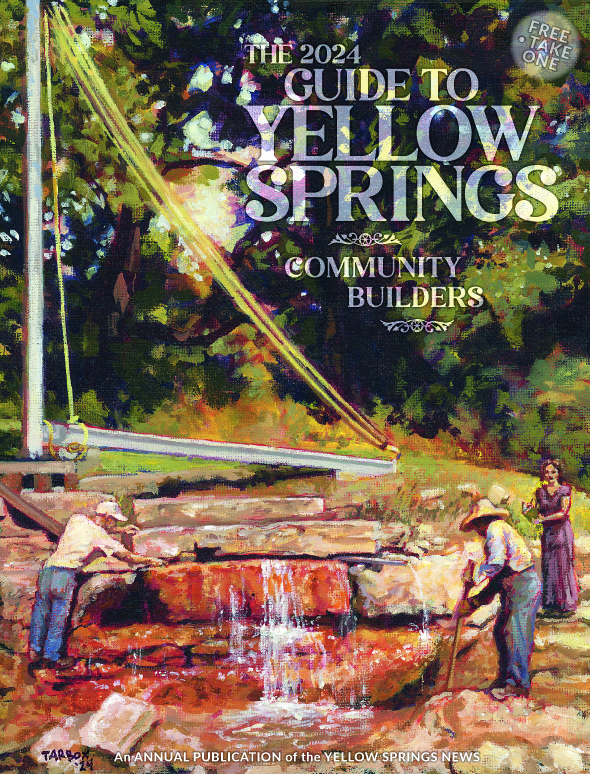Dress code comment spurs controversy
- Published: May 16, 2019
A woman who works in food service at the high school faces the possibility of losing her job after separate public and private social media posts came to the attention of school officials last week.
Bonita Pence, the on-site manager for Sodexo Food Service, was placed on leave Friday, May 3, after an online firestorm erupted the day before in response to her writing in a local Yellow Springs Open Discussion Facebook forum, about the length of the shorts being worn by some high school girls. She expressed the opinion that the wearing of “short shorts,” which she said revealed the girls’ “butt cheeks,” was inappropriate in school. The post, which elicited multiple comments both critical and supportive of her view, has since been removed.
Amidst the debate, a racially offensive meme that Pence had shared at an earlier date on her private Facebook page was copied by another Facebook user to the public forum page. It, too, has since been removed, and is no longer visible on Pence’s private page.
The upper half of the meme shows a Confederate flag topped by the sentence “This does not offend me.” The bottom half says, “This bull(expletive) does!” with arrows pointing to a photograph from behind of two males wearing pants that fall below the tops of boxer shorts. One of the males appears to be a person of color, the race of the other is ambiguous.
The message of the meme, in addition to concern over a worker in the school making public comments about students, prompted the school district to contact Sodexo, Pence’s employer, according to district Superintendent Mario Basora in a letter to district families May 3.
The meme “communicates racism and a lack of empathy and understanding of the painful history and symbolism of the Confederate flag and its impact on African Americans historically,” Basora wrote. “We as a community value diversity, equity, and justice. This type of communication does not represent Yellow Springs Schools and what we value as a school community.”
Sodexo management is investigating the Facebook posts, Basora wrote.
The company’s local site manager, Cindy DeZarn, who is based in Middletown, said by phone Tuesday that she was “not allowed to comment at this time” on the matter, and she referred questions to Sodexo’s public relations representatives, who had not responded by press time.
Stunned by reactions
For her part, Pence is confused and hurt by the actions against her.
Reached by phone at her home Monday, May 6, she said she has been put on paid “investigative administrative” leave for the time being, but she anticipates she’ll be fired and has contacted a lawyer.
She declined to say who informed her of the disciplinary action or how she was informed, but said no one with the school district has contacted her.
A longtime village resident who has worked in the schools for 15 years, the last nine for Sodexo, Pence said she is stunned by the level of vitriol directed at her by some in town.
“I’ve been in this community for over 40 years, and never have I seen anything like this,” she said. “It’s turned into not just about my [girls’ shorts] post, it’s turned into they’re trying to say I’m racist.”
She doesn’t understand the accusation.
“I feel like I was tried and convicted,” she said.
As for her original social media post about girls’ clothing choices, Pence said she went to the community forum out of a maternal place of concern.
“I posted as a mother and a grandmother,” she said.
And she stands behind her assertion that the shorts that some girls wear are inappropriate for the school setting.
“When the shorts look like a thong instead of shorts, to me that’s too much,” she said.
Dress code rules
Rules for student attire are listed in both the Board of Education’s Policy Manual and the high/middle school Student Handbook.
According to its dress and grooming policy, adopted in 1998, the school board “recognizes that each student’s mode of dress and grooming is a manifestation of personal style and individual preference.”
The policy goes on to state that the district won’t interfere with the right of students and their guardians to make decisions about their appearance, “except when their choices interfere with the educational program of the schools.”
At the same time, it gives administrators the authority to establish guidelines necessary “to promote discipline, maintain order, secure the safety of students, and provide a healthy environment conducive to academic purposes.” And it designates principals as the arbiter of student dress and grooming in their respective buildings.
According to the high/middle school handbook, “the goal of the dress code is to promote a professional atmosphere in [the] school while remaining inclusive of a diverse range of identities.”
Among the specifically stated rules is the stipulation that “clothes must be worn in a way such that genitals, buttocks, breasts, and nipples are fully and securely covered with opaque fabric.”
High/middle school Principal Jack Hatert said this week that he feels good about the school’s dress code, which was updated last spring.
“Historically, the dress code is an issue in every school in America every year,” he said.
He noted that dress codes have traditionally “targeted women,” focusing on female clothing choices. The district’s desire to make the local code less gender specific was at the heart of the recent update, he said.
“We don’t want to hold our young ladies to a different standard.”
The local code also attempts to reflect the wider community’s values, Hatert said, including the belief that students have the right “to express themselves through their dress.”
Finding the right balance is the challenge, he said.
He estimated that there have been four or five dress code violations this year.
“It’s not something that for me is a huge concern,” he said. “If that’s the biggest issue [here], then this place is running really well,” he added.
Student response
Senior Alex Ronnebaum believes the school’s dress code is sound.
“I’m proud of the school dress code that students helped write,” she wrote in an email this week. “As long as students are dressed within the dress code, then there is not a problem.”
Part of this year’s homecoming royalty, co-captain of the volleyball team and a robotics competitor, Ronnebaum takes issue with the notion that short shorts at school are inappropriate. And she also challenges any community members who expressed the idea that “the girls who dress this way are lacking in self-respect.”
“It is 2019, and it is about time that our society stops policing girls’ bodies!” she wrote. “Our bodies are not inappropriate! … We do not need modesty culture or body shaming in our school. Students should feel free to dress how they are comfortable. Other [people] should focus on themselves if they find themselves distracted by what others are wearing.”
Senior classmate Tabitha Weaver, however, is less comfortable with some of the clothes worn at school, and she feels the school isn’t adhering enough to dress code rules.
“What Miss Bonita posted about, she was absolutely right about the short shorts,” Weaver, a manager at the American Eagle retail store, said in a phone call this week.
“In the warmer weather it gets pretty bad,” she said. “I don’t want to see butts hanging out.”
Despite the difference of opinion with some of her peers, Weaver said the topic isn’t a source of conflict between students. She believes, though, that there are plenty of other clothing choices students can make to be comfortable and fashionable.
Fashion trend
Short shorts have been in and out of fashion for decades. Local residents of a certain age may remember the Nair hair removal product’s nationally televised commercial “Who wears short shorts?” that debuted in the 1970s and was inspired by a 1957 song of the same name. A new round of commercials sporting the same tag line appeared in the mid-’80s. In the same era, “Daisy Dukes,” named for the character who wore short jean cutoffs on TV’s “Dukes of Hazard,” further popularized — and stigmatized — a relationship between short shorts and feminine attractiveness.
Today, Mudd brand shorts, carried by most leading retail stores in the country, is at the forefront of the trend’s current incarnation.
Mudd’s advertising message stresses self-expression and autonomy, though critics see that message as disingenuous:
“Mudd girls are effortlessly cool while committed to expressing their individuality. They stay true to their unique style and have fun in the process. Mudd girls stand up, stand out and make their dreams a reality. They lead by action, and know they can impact the future.”
Contemporary music, television and internet celebrities also sport the style, increasing its trendiness.
Sexualization of girls
In attributing motives for the current short shorts trend, however, some commentators on Bonita Pence’s Facebook post took the discussion in a direction that sexualized the girls and their intent.
That sexualization is of particular concern for Ronnenbaum, as well as a number of separate commentators on Pence’s post who challenged the monitoring of girls’ clothing choices.
According to the American Psychological Association’s Task Force on the sexualization of girls, sexualization occurs when:
• A person’s value comes only from his or her sexual appeal or behavior, to the exclusion of other characteristics;
• A person is held to a standard that equates physical attractiveness with being sexy;
• A person is sexually objectified — that is, made into a thing for others’ sexual use, rather than seen as a person with a capacity for independent action and decision making; and/or
• Sexuality is inappropriately imposed upon a person.
Arguments that girls’ clothing causes a distraction and hinders learning puts the onus on them to ensure the comfort of others.
Two years ago, a Portland, Maine, middle-schooler and her mother started a campaign, #Iamnotadistraction, after the girl and a friend were removed from class because of their attire.
The girls contended that the only distraction came from the school’s actions, not the pair’s clothing. The hashtag campaign continues on Twitter, Instagram and Facebook, where other such instances across the country are highlighted and challenged.
Principal Hatert agrees that focusing on clothes gets in the way of learning.
“We don’t want to be judging students by how they’re dressed,” he said.
Freedom of expression
While the local schools recognize students’ right to express themselves through their clothing choices, the law of the land is less clear. The Supreme Court hasn’t addressed the Constitutionality of dress codes directly, but during the Vietnam War affirmed students’ right to free speech in the wearing of black arm bands in protest of the war.
Bonita Pence, whose Facebook posts stirred local controversy, believes her case is also one of free speech, though she didn’t want to say more than that for fear of retribution.
“I want my job back,” she said.
The line between private and public expression can be muddy on Facebook, which is currently under scrutiny as to its purpose as either a platform or a publisher.
There are documented instances of employees across the country being fired for personal Facebook posts, but the circumstances are case by case.
Pence is hoping to stay with the school.
“I love my job; I love the kids,” she said.
The Yellow Springs News encourages respectful discussion of this article.
You must login to post a comment.
Don't have a login? Register for a free YSNews.com account.















No comments yet for this article.